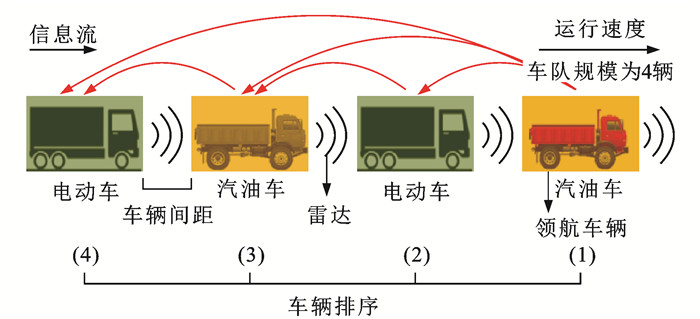A method of heterogeneous truck platoon formation for low energy consumption based on vehicle ranking
-
摘要: 考虑了燃油车和电动车动力系统差异以及货车车型对队列运营节能效果的影响,基于货车物理能耗模型和车形节能关系矩阵,建立了不同类型货车队列的能耗表征模型;为了不损失队列运营效率,构建了货车队列运营节能模型;以队列运营节能效益最大为目标,以不同类型货车数量、队列长度、队列排序位置要求为约束,建立了异质性货车队列低能耗配置优化模型,优化了队列规模和各个队列内部的车辆排序;基于数值试验,量化分析了异质性队列节能情况,解析了队列行驶工况、节能系数、不同车型比例对能耗的影响规律。研究结果表明:相较于独立行驶,12、18辆车试验的异质性货车队列运营节能率分别为6.5%、6.6%;相较于同质性队列,12、18辆车试验的异质性队列节能率分别增大了4.6%和4.8%;异质性货车队列配置情况不随行驶工况的变化而变化,但相较于匀速行驶状态,加速状态下节能率相对较低,约为3.6%;就车型排列规律而言,首先应依据“钟形”规律排布燃油车,其次应按照“钟形”规律插入电动车,使电动车帮助燃油车减少能耗,最后应优先配置队列前方位置;队列运营节能率随着速度的提升而增大,弹性系数为0.05,表明了队列技术在高速公路场景下可带来较为可观的效益;随着电动车比例的不断增大,队列节能率略有增加;节能系数对队列节能率影响最大,弹性系数为1.2。Abstract: Considering the power system difference between petrol vehicles and electric vehicles, and the influence of truck type on energy-saving effect in a platoon, the energy consumption characterization model of different truck platoon was proposed based on the truck physical energy consumption model and the energy-saving relationship matrix. The energy-saving model of a truck platoon was constructed to avoid the platoon operation efficiency loss. To maximize the energy-saving benefit of platoon operation, an optimization model of the heterogeneous truck platoon for low energy consumption was built with the constraints of truck quantities, platoon lengths, and platoon ranking positions, and then the platoon sizes and vehicle ranking for each platoon were optimized. Based on numerical experiments, the energy-saving performance of heterogeneous platoon was quantitatively analyzed, and the influence rules of driving conditions, energy-saving coefficient, and the proportion of vehicle type on energy consumption were analyzed. Research results show that compared with independent driving, the energy-saving rate of the heterogeneous truck platoon is 6.5% and 6.6% in the experiments with 12 and 18 vehicles, respectively. Compared with the homogeneous platoon, the energy-saving rate of the heterogeneous truck platoon increases by 4.6% and 4.8% in the experiments with 12 and 18 vehicles, respectively. The formation of heterogeneous truck platoon does not change with the driving conditions. Compared with the constant speed condition, the energy-saving rate is about 3.6% and relatively lower in the accelerated condition. In terms of vehicle ranking principles, petrol vehicles should be arranged according to the bell principle. Electric vehicles should be inserted according to the bell principle and are used to help petrol vehicles reduce energy consumption. Finally, priority should be given to the front positions of a platoon. With the rising speed, the energy-saving rate of a platoon increases with an elasticity of 0.05, which indicates that platoon technology can bring considerable benefit on the highway scenario. With the increasing proportion of electric vehicles, the energy-saving rate of the platoon rises slightly. The energy-saving coefficient exerts the greatest influence on the energy-saving rate of the platoon, with an elasticity of 1.2.
-
表 1 三种类型货车信息
Table 1. Information of three types of trucks
车辆属性 小型车 中型车 大型车 车型分类 m≤3 500 kg 3 500 kg < m≤12 000 kg 车身长度/m 5.1 6.2 9.8 整车质量/kg 1 000 2 500 5 000 车前迎风面积/m2 3.03 4.33 6.23 表 2 试验场景
Table 2. Experimental scenarios
试验场景 具体描述 研究内容 场景1:同质性货车队列匀速运营 货车队列以80 km·h-1的速度匀速行驶120 km 同质性与异质性队列运营节能差异 场景2:异质性货车队列匀速运营 货车队列以80 km·h-1的速度匀速行驶120 km 车辆排序规律与节能敏感性(节能系数、运行速度、车型配置影响) 场景3:异质性货车队列(匀速- 加速-匀速) 货车队列以70 km·h-1的速度匀速行驶5 km;然后以0.5 m·s-2加速度加速至90 km·h-1;最后以90 km·h-1的速度匀速行驶5 km 加速过程影响 表 3 相邻货车安全间距
Table 3. Safety distances between adjacent trucks
相邻车型 安全间距/m 小-小 3 中-中 5 大-大 7 小-中 4 小-大 5 中-大 6 表 4 节能系数e1, ij取值
Table 4. Values of energy-saving coefficient e1, ij
前方车型 后方车型 小型车 中型车 大型车 小型车 0.93 0.94 0.95 中型车 0.92 0.93 0.94 大型车 0.91 0.92 0.93 表 5 节能系数e2, ij取值
Table 5. Values of energy-saving coefficient e2, ij
前方车型 后方车型 小型车 中型车 大型车 小型车 0.970 0.965 0.960 中型车 0.975 0.970 0.965 大型车 0.980 0.975 0.970 表 6 异质性货车队列节能情况
Table 6. Energy-saving situation for heterogeneous truck platoons
试验 试验1 试验2 车型配置 (2,2,2,2,2,2) (3,3,3,3,3,3) 独立行驶时的能耗/kg 196.086 294.129 列队行驶节省能耗/kg 12.665 19.259 节能率/% 6.5 6.6 表 7 同质性和异质性队列运营能耗比较
Table 7. Comparison of energy consumption between homogeneous platoon and heterogeneous platoon
试验 试验3 试验4 车型配置 (4,4,4,0,0,0) (0,0,0,4,4,4) 独立行驶时的能耗/kg 297.884 94.287 同质性队列节省能耗(3个队列)/kg 14.148 5.048 异质性队列节省能耗(3个队列)/kg 14.801 5.290 表 8 加速过程节能率
Table 8. Energy-saving rates in acceleration process
能耗情况 只计算加速过程 匀速-加速-匀速同时计算 独立行驶时的能耗/kg 0.713 17.598 列队行驶节省能耗/kg 0.026 1.125 节能率/% 3.6 6.4 表 9 考虑队列长度约束后的节能情况
Table 9. Energy-saving situation with platoon length constraint
试验 试验5 试验6 车型配置 (2,2,2,2,2,2) (3,3,3,3,3,3) 独立行驶时的能耗/kg 196.086 294.129 列队行驶节省能耗/kg 12.031 18.034 节能率/% 6.1 6.1 表 10 大、中、小型车比例对队列节能情况的影响
Table 10. Effect of large-medium-small truck proportions on energy-saving of platoon
车型配置 独立行驶能耗/ kg 队列行驶节省能耗/ kg 节能率/ % (1,2,3,1,2,3) 223.655 14.139 6.3 (2,2,2,2,2,2) 196.086 12.665 6.4 (3,2,1,3,2,1) 168.517 11.062 6.6 表 11 电动车、燃油车比例对队列节能情况的影响
Table 11. Effect of electric-petrol truck proportions on energy-saving of platoon
车型配置 独立行驶能耗/ kg 队列行驶节省能耗/ kg 节能率/ % (1,1,1,3,3,3) 145.185 9.586 6.8 (2,2,2,2,2,2) 196.086 12.665 6.4 (3,3,3,1,1,1) 246.987 15.454 6.2 -
[1] BIBEKA A, SONGCHITRUKSA P, ZHANG Y L. Assessing environmental impacts of ad-hoc truck platooning on multilane freeways[J]. Journal of Intelligent Transportation Systems, 2021, 25(3): 281-292. doi: 10.1080/15472450.2019.1608441 [2] ZHANG L L, CHEN F, MA X X, et al. Fuel economy in truck platooning: a literature overview and directions for future research[J]. Journal of Advanced Transportation, 2020, 2020: 2604012. [3] BROWAND F, MCARTHUR J, RADOVICH C. Fuel saving achieved in the field test of two tandem trucks[R]. Berkeley: UC Berkeley, 2004. [4] MICHAELIAN M, BROWAND F. Field experiments demonstrate fuel savings for close following[R]. Berkeley: UC Berkeley, 2000. [5] 谭二龙, 李宏海, 钟厚岳, 等. 基于轨迹数据的货车自发编队节油潜力估计[J]. 交通运输系统工程与信息, 2022, 22(1): 74-84. doi: 10.16097/j.cnki.1009-6744.2022.01.009TAN Er-long, LI Hong-hai, ZHONG Hou-yue, et al. Estimating truck spontaneous platoon fuel-saving potential based on trajectory data[J]. Journal of Transportation Systems Engineering and Information Technology, 2022, 22(1): 74-84. (in Chinese) doi: 10.16097/j.cnki.1009-6744.2022.01.009 [6] YANG X T, HUANG K, ZHANG Z H, et al. Eco-driving system for connected automated vehicles: multi-objective trajectory optimization[J]. IEEE Transactions on Intelligent Transportation Systems, 2021, 22(12): 7837-7849. doi: 10.1109/TITS.2020.3010726 [7] CHOWDHURY T, PARK P Y, GINGERICH K. Operational impact of the through-traffic signal prioritization for heavy commercial vehicle platooning on urban arterials[J]. Transportation Research Record, 2023, 2677(2): 62-77. doi: 10.1177/03611981221127287 [8] YE Qian-wen, CHEN Xu-mei, LIAO Ruo-hua, et al. Development and evaluation of a vehicle platoon guidance strategy at signalized intersections considering fuel savings[J]. Transportation Research Part D: Transport and Environment, 2019, 77: 120-131. doi: 10.1016/j.trd.2019.10.020 [9] 王姝. 面向货车队列速度优化的多车道高速公路货车车道管理策略研究[D]. 南京: 东南大学, 2020.WANG Shu. Truck lane management strategies for speed optimized truck platooning in a multi-lane freeway[D]. Nanjing: Southeast University, 2020. (in Chinese) [10] HU Yu-ying, CHEN Cai-lian, HE Jian-ping, et al. Eco-platooning for cooperative automated vehicles under mixed traffic flow[J]. IEEE Transactions on Intelligent Transportation Systems, 2021, 22(4): 2023-2034. doi: 10.1109/TITS.2021.3056122 [11] YANG Z, FENG Y H, LIU H X. A cooperative driving framework for urban arterials in mixed traffic conditions[J]. Transportation Research Part C: Emerging Technologies, 2021, 124: 102918. doi: 10.1016/j.trc.2020.102918 [12] JIANG S M, PAN T L, ZHONG R X, et al. Coordination of mixed platoons and eco-driving strategy for a signal-free intersection[J]. IEEE Transactions on Intelligent Transportation Systems, 2022, DOI: 10.1109/TITS.2022.3211934. [13] CHEN J, QIAN L J, XUAN L, et al. Hierarchical eco-driving control strategy for hybrid electric vehicle platoon at signalized intersections under partially connected and automated vehicle environment[J]. IET Intelligent Transport Systems, 2022, DOI: 10.1049/itr2.12325. [14] SUN X T, WU H C, ABDOLMALEKI M, et al. Investigating the potential of truck platooning for energy savings: empirical study of the US national highway freight network[J]. Transportation Research Record, 2021, 2675(12): 784-796. doi: 10.1177/03611981211031231 [15] 卢自宝, 田凯健, 方明星, 等. 基于运输成本的高速公路车辆协同调度与速度规划[J]. 控制与决策, https://doi.org/10.13195/j.kzyjc.2021.1797.LU Zi-bao, TIAN Kai-jian, FANG Ming-xing, et al. Cooperative scheduling and speed planning of vehicles on highways based on transportation cost[J]. Control and Decision, https://doi.org/10.13195/j.kzyjc.2021.1797. (in Chinese) [16] CHEN S K, WANG H, MENG Q. Autonomous truck scheduling for container transshipment between two seaport terminals considering platooning and speed optimization[J]. Transportation Research Part B: Methodological, 2021, 154: 289-315. doi: 10.1016/j.trb.2021.10.014 [17] XU W J, CUI T T, CHEN M H. Optimizing two-truck platooning with deadlines[J]. IEEE Transactions on Intelligent Transportation Systems, 2023, 24(1): 694-705. doi: 10.1109/TITS.2022.3213549 [18] ZHANG W, JENELIUS E, MA X L. Freight transport platoon coordination and departure time scheduling under travel time uncertainty[J]. Transportation Research Part E: Logistics and Transportation Review, 2017, 98: 1-23. doi: 10.1016/j.tre.2016.11.008 [19] LI Qian-wen, LI Xiao-ping. Trajectory planning for autonomous modular vehicle docking and autonomous vehicle platooning operations[J]. Transportation Research Part E: Logistics and Transportation Review, 2022, 166: 102886. doi: 10.1016/j.tre.2022.102886 [20] BOUCHERY Y, HEZARKHANI B, STAUFFER G. Coalition formation and cost sharing for truck platooning[J]. Transportation Research Part B: Methodological, 2022, 165: 15-34. doi: 10.1016/j.trb.2022.08.007 [21] JOHANSSON A, BAI T, JOHANSSON K H, et al. Platoon cooperation across carriers: from system architecture to coordination[J]. IEEE Intelligent Transportation Systems Magazine, 2023, 15(3): 132-144. doi: 10.1109/MITS.2022.3219997 [22] SCHOLL J, BOYSEN N, SCHOLL A. E-platooning: optimizing platoon formation for long-haul transportation with electric commercial vehicles[J]. European Journal of Operational Research, 2023, 304(2): 525-542. doi: 10.1016/j.ejor.2022.04.013 [23] ZENG Y K, WANG M, RAJAN R T. Decentralized coordination for truck platooning[J]. Computer-Aided Civil and Infrastructure Engineering, 2022, 37(15): 1997-2015. doi: 10.1111/mice.12899 [24] LARSSON E, SENNTON G, LARSON J. The vehicle platooning problem: computational complexity and heuristics[J]. Transportation Research Part C: Emerging Technologies, 2015, 60: 258-277. doi: 10.1016/j.trc.2015.08.019 [25] SIVANANDHAM S, GAJANAND M S. Comparison of platoon formations using departure time coordination heuristic[J]. International Journal of Operational Research, 2022, 43(1/2): 96-118. doi: 10.1504/IJOR.2022.121487 [26] VAN DE HOEF S, JOHANSSON K H, DIMAROGONAS D V. Fuel-efficient en route formation of truck platoons[J]. IEEE Transactions on Intelligent Transportation Systems, 2018, 19(1): 102-112. doi: 10.1109/TITS.2017.2700021 [27] LARSEN R, RICH J, RASMUSSEN T K. Hub-based truck platooning: potentials and profitability[J]. Transportation Research Part E: Logistics and Transportation Review, 2019, 127: 249-264. doi: 10.1016/j.tre.2019.05.005 [28] ABDOLMALEKI M, SHAHABI M, YIN Y F, et al. Itinerary planning for cooperative truck platooning[J]. Transportation Research Part B: Methodological, 2021, 153: 91-110. doi: 10.1016/j.trb.2021.08.016 [29] BOYSEN N, BRISKORN D, SCHWERDFEGER S. The identical-path truck platooning problem[J]. Transportation Research Part B: Methodological, 2018, 109: 26-39. doi: 10.1016/j.trb.2018.01.006 [30] SCHITO P, BRAGHIN F. Numerical and experimental investigation on vehicles in platoon[J]. SAE International Journal of Commercial Vehicles, 2012, 5(1): 63-71. doi: 10.4271/2012-01-0175 [31] 樊贤俊. 车路协同背景下三种货运车辆队列节能仿真研究[D]. 长春: 吉林大学, 2021.FAN Xian-jun. Simulation research on energy conservation of three types of freight vehicle platoon under the background of vehicle-road coordination[D]. Changchun: Jilin University, 2021. (in Chinese) [32] ZHEN H, MOSHARAFIAN S, YANG J J, et al. Eco-driving trajectory planning of a heterogeneous platoon in urban environments[J]. IFAC-PapersOnLine, 2022, 55(24): 161-166. doi: 10.1016/j.ifacol.2022.10.278 [33] ESMAEILI S, KIM Y H. A platoon formation strategy for heterogeneous vehicle types at a signalized intersection[C]//IEEE. IEEE 25th Conference on Intelligent Transportation Systems. New York: IEEE, 2022: 3543-3548. [34] HE X, WU X. Eco-driving advisory strategies for a platoon of mixed gasoline and electric vehicles in a connected vehicle system[J]. Transportation Research Part D: Transport and Environment, 2018, 63: 907-922. doi: 10.1016/j.trd.2018.07.014 [35] 侯登凯, 范厚明, 任晓雪. 时变路网下多中心混合车队联合配送车辆路径优化[J]. 大连海事大学学报, 2022, 48(1): 11-22. https://www.cnki.com.cn/Article/CJFDTOTAL-DLHS202201002.htmHOU Deng-kai, FAN Hou-ming, REN Xiao-xue. Vehicle routing optimization of multi-center hybrid fleet joint distribution under time-varying road network[J]. Journal of Dalian Maritime University, 2022, 48(1): 11-22. (in Chinese) https://www.cnki.com.cn/Article/CJFDTOTAL-DLHS202201002.htm [36] LEE W J, KWAG S I, KO Y D. The optimal eco-friendly platoon formation strategy for a heterogeneous fleet of vehicles[J]. Transportation Research Part D: Transport and Environment, 2021, 90: 102664. doi: 10.1016/j.trd.2020.102664 [37] BIGGS D C, AKCELIK R. An energy-related model of instantaneous fuel consumption[J]. Traffic Engineering and Control, 1986, 27(6): 320-325. [38] WU X K, FREESE D, CABRERA A, et al. Electric vehicles' energy consumption measurement and estimation[J]. Transportation Research Part D: Transport and Environment, 2015, 34: 52-67. doi: 10.1016/j.trd.2014.10.007 -





 下载:
下载:










